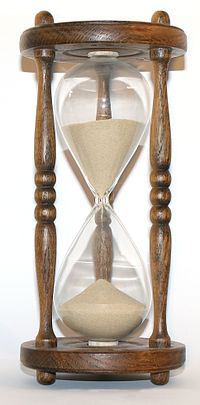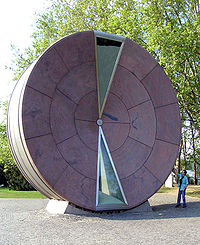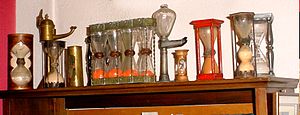- Hourglass
-
For other uses, see Hourglass (disambiguation).
An hourglass (sandglass, sand timer, sand clock, egg timer) measures the passage of a few minutes or an hour of time. It has two connected vertical glass bulbs allowing a regulated trickle of material from the top to the bottom. Once the top bulb is empty, it can be inverted to begin timing again. The name hourglass comes from historically common hour timing. Factors affecting the time measured include the amount of sand, the bulb size, the neck width, and the sand quality. Alternatives to sand are powdered eggshell and powdered marble[1] (sources disagree on the best material). In modern times, hourglasses are ornamental, or used when an approximate measure suffices, as in egg timers for cooking or for board games.
Contents
History
 Temperance bearing an hourglass; detail of Lorenzetti's Allegory of Good Government, 1338
Temperance bearing an hourglass; detail of Lorenzetti's Allegory of Good Government, 1338
The origin of the hourglass is unclear, although it may have been introduced to Europe by an 8th-century monk named Luitprand, who served at the cathedral in Chartres, France. [2] It was not until the 14th century that the hourglass was seen commonly, the earliest firm evidence being a depiction in the 1338 fresco Allegory of Good Government by Ambrogio Lorenzetti.[3] Unlike its predecessor the clepsydra, or water clock, which may have been invented in ancient Egypt, the hourglass is believed to have originated in medieval Europe.[4] This theory is based on the fact that the first written records of it were mostly from logbooks of European ships. [4] Written records from the same period mention the hourglass, and it appears in lists of ships stores. An early record is a sales receipt of Thomas de Stetesham, clerk of the English ship La George, in 1345:
"The same Thomas accounts to have paid at Lescluse, in Flanders, for twelve glass horologes (" pro xii. orlogiis vitreis "), price of each 4½ gross', in sterling 9s. Item, For four horologes of the same sort (" de eadem secta "), bought there, price of each five gross', making in sterling 3s. 4d."[5]
Hourglasses were very popular on board ships, as they were the most dependable measurement of time while at sea. Unlike the clepsydra, the motion of the ship while sailing did not affect the hourglass. The fact that the hourglass also used granular materials instead of liquids gave it more accurate measurements, as the clepsydra was prone to get condensation inside it during temperature changes. [6] Seamen found that the hourglass was able to help them determine longitude, distance east or west from a certain point, with reasonable accuracy. [6]
The hourglass also found popularity on land as well. As the use of mechanical clocks to indicate the times of events like church services became more common, creating a ‘need to keep track of time’, the demand for time-measuring devices increased. Hourglasses were essentially inexpensive, as they required no rare technology to make and their contents were not hard to come by, and as the manufacturing of these instruments became more common, their uses became more practical. [6]
Hourglasses were commonly seen in use in churches, homes, and work places to measure sermons, cooking time, and time spent on breaks from labor. [4] Because they were being used for more everyday tasks, the model of the hourglass began to shrink. The smaller models were more practical and very popular as they made timing more discreet.
After 1500 A.D., the hourglass was not as widespread as it had been. This was due to the development of the mechanical clock, which became more accurate, smaller and cheaper, and made keeping time easier. [2] The hourglass, however, did not disappear entirely. Although they became relatively less useful as clock technology advanced, hourglasses remained desirable in their design. Some of the most famous hourglasses are the twelve-hour hourglass of Charlemagne of France and the hourglasses of Henry the VIII of England, made by the artist Holbein in the 16th century. [2] The oldest known surviving hourglass resides in the British Museum in London. [4]
Not until the 18th century did the Harrison brothers, John and James, come up with a marine chronometer that significantly improved on the stability of the hourglass at sea. Taking elements from the design logic behind the hourglass, they were able to invent a marine chronometer that was able to accurately measure the journey from England to Jamaica, with only a miscalculation of five seconds, in 1761. [2]
Design
The shape behind the hourglass has hardly any written evidence of why its external form is the shape that it is. The glass bulbs used, however, have changed in style and design over time. While the main designs have always been ampoule in shape, the bulbs were not always connected. The first hourglasses were two separate bulbs with a cord wrapped at their union that was then coated in wax to hold the piece together and let sand flow in between. [2] It was not until 1760 that both bulbs were blown together to keep moisture out of the bulbs and regulate the pressure within the bulb that varied the flow of the granular substance. [6]
Material
While some hourglasses actually did use sand as the granular mixture to measure time, many did not use sand at all. The material used in most bulbs was a combination of “powdered marble, tin/lead oxides, and pulverized, burnt eggshell”. [4] Over time, different textures of granule matter were tested to see which gave the most constant flow within the bulbs. It was later discovered that for the perfect flow to be achieved the ratio of granule bead to the width of the bulb neck needed to be 1/12 or more but not greater than 1/2 the neck of the bulb. [7]
Practical uses
Hourglasses were an early dependable, reusable and accurate measure of time. The rate of flow of the sand is independent of the depth in the upper reservoir, and the instrument will not freeze in cold weather.[4]
From the 15th century onwards, they were being used in a range of applications at sea, in the church, in industry and in cookery.
During the voyage of Ferdinand Magellan around the globe, his vessels kept 18 hourglasses per ship. It was the job of a ship's page to turn the hourglasses and thus provide the times for the ship's log. Noon was the reference time for navigation, which did not depend on the glass, as the sun would be at its zenith.[8] More than one hourglass was sometimes fixed in a frame, each with a different running time, for example 1 hour, 45 minutes, 30 minutes, and 15 minutes.
Modern practical uses
While they are no longer widely used for keeping time, some institutions do maintain them. Both houses of the Australian Parliament use three hourglasses to time certain procedures, such as divisions.[9]
The sandglass is still widely used as the kitchen egg timer; for cooking eggs, a three minute timer is typical,[10] hence the name "egg timer" for three minute hourglasses. Egg timers are sold widely as souvenirs.[citation needed]
Sand timers are also sometimes used in games such as Pictionary and Boggle to implement a time constraint on rounds of play, and provide a sense of urgency to the game of Quicksand.
Symbolic uses
 Pirate Christopher Moody's "Bloody Red" jack, c. 1714
Pirate Christopher Moody's "Bloody Red" jack, c. 1714
Unlike most other methods of measuring time, the hourglass concretely represents the present as being between the past and the future, and this has made it an enduring symbol of time itself.
The hourglass, sometimes with the addition of metaphorical wings, is often depicted as a symbol that human existence is fleeting, and that the "sands of time" will run out for every human life.[11] It was used thus on pirate flags, to strike fear into the hearts of the pirates' victims. In England, hourglasses were sometimes placed in coffins,[12] and they have graced gravestones for centuries. The hourglass was also used in alchemy as a symbol for hour.
Modern symbolic uses
Recognition of the hourglass as a symbol of time has survived its obsolescence as a timekeeper. For example, the American television soap opera Days of our Lives, since its first broadcast in 1965, has displayed an hourglass in its opening credits, with the narration, "Like sands through the hourglass, so are the days of our lives," spoken by Macdonald Carey.
Various computer programs and earlier versions of Windows may change the mouse cursor to an hourglass during a period when the program is in the middle of a task, and may not accept user input. During that period other programs, for example in different windows, may work normally. When a Windows hourglass does not disappear, it suggests a program is in an infinite loop and needs to be terminated, or is waiting for some external event (such as the user inserting a CD). Unicode has an HOURGLASS symbol at
U+231B(⌛).Hourglass motif
Because of its symmetry, graphic signs resembling an hourglass are seen in the art of cultures which never encountered such objects. Vertical pairs of triangles joined at the apex are common in Native American art; both in North America,[13] where it can represent, for example, the body of the Thunderbird or (in more elongated form) an enemy scalp,[14][15] and in South America, where it is believed to represent a Chuncho jungle dweller.[16] In Zulu textiles they symbolise a married man, as opposed to a pair of triangles joined at the base, which symbolise a married woman.[17] Neolithic examples can be seen among Spanish cave paintings.[18][19] Observers have even given the name "hourglass motif" to shapes which have more complex symmetry, such as a repeating circle and cross pattern from the Solomon Islands.[20]
Hourglass body shape
Hourglass also refers to a body shape of women. In this shape bust and hip are significantly large with narrow waist resembling the shape of an hourglass. A common measurement of shape is 36 24 36 (size in inches). Even clothes to hug body of hourglass shape are available such as an hourglass corset.
See also
References
- ^ Madehow.com (2006). "Hourglass". How Products Are Made, vol. 5. Madehow.com. http://www.madehow.com/Volume-5/Hourglass.html. Retrieved 2008-02-04.
- ^ a b c d e [1]
- ^ Frugoni, Chiara (1988). Pietro et Ambrogio Lorenzetti. Scala Books. p. 83. ISBN 0935748806.
- ^ a b c d e f Mills, A. A., S. Day, and S. Parkes. "Mechanics of the sandglass." Eur. J. Phys. 17 (1996): 97-109.
- ^ Nicolas, Nicholas Harris (1847). A History of the Royal Navy, from the earliest times to the wars of the French revolution, vol. II. London: Richard Bentley. p. 476. http://books.google.com/?id=rh8EAAAAQAAJ.
- ^ a b c d Balmer, R. T. “The Operation of Sand Clocks and Their Medieval Development.” Technology and Culture, Vol. 19, No. 4 (Oct., 1978), pp. 615-632 Balmer, R. T. “The Operation of Sand Clocks and Their Medieval Development.” Technology and Culture, Vol. 19, No. 4 (Oct., 1978), pp. 615-632.
- ^ Peterson, Ivars. "Trickling sand: how an hourglass ticks". Science News, Vol. 144, No. 11 (September 11, 1993). p. 167
- ^ Bergreen, Laurence (2003). Over the Edge of the World: Magellan's Terrifying Circumnavigation of the Globe. William Morrow. ISBN 0066211735.
- ^ Senate of Australia (26 March 1997) (PDF). Official Hansard. pp. 2472. http://www.aph.gov.au/hansard/senate/dailys/ds260397.pdf.
- ^ Herbst, Sharon Tyler (2001). The New Food Lover's Companion. Barron's Educational Series.
- ^ Room, Adrian (1999). Brewer's Dictionary of Phrase and Fable. New York: HarperCollinsPublishers. http://www.phrases.org.uk/bulletin_board/17/messages/288.html. "Time is getting short; there will be little opportunity to do what you have to do unless you take the chance now. The phrase is often used with reference to one who has not much longer to live. The allusion is to the hourglass."
- ^ Ewbank, Thomas (1857). A Descriptive and Historical Account of Hydraulic and Other Machines for Raising Water, Ancient and Modern With Observations on Various Subjects Connected with the Mechanic Arts, Including the Progressive Development of the Steam Engine. Vol. 1. New York: Derby & Jackson. p. 547. http://books.google.com/?id=PxEKAAAAIAAJ. "Hour-glasses were formerly placed in coffins and buried with the corpse, probably as symbols of mortality—the sands of life having run out. See Gent. Mag. vol xvi, 646, and xvii, 264."
- ^ Splendid Heritage: treasures of native american art (search on "hourglass")
- ^ Wishart, David J. (ed.) Encyclopedia of the Great Plains University of Nebraska Press (2004) ISBN 0803247877, p125
- ^ Philip, Neil The Great Mystery: Myths of Native America, Clarion Books (2001) ISBN 039598405X , p64-65]
- ^ Wilson, Lee Ann Nature Versus Culture in Textile Traditions of Mesoamerica and the Andes: An Anthology (ed. Schevill, M.B. et al.), University of Texas Press (1996) ISBN 0292777140
- ^ An African Valentine: The Bead Code of the Zulus, edunetconnect.com
- ^ Greenman, E.F. The Upper Palaeolithic and the New World in Current Anthropology Vol. 4, No. 1 (Feb., 1963), pp. 41-91 (NB: includes reviews disputing the central thesis and methodology)- via JSTOR (subscription)
- ^ Image, "Croquis 1872" (click to enlarge) at colonias.iespana.es
- ^ Craig, Barry A Stone Tablet from Buka Island in Archaeological Studies of the Middle and Late Holocene, Papua New Guinea (Technical Report 20) (ed. Specht, Jim & Attenbrow, Val) Australian Museum (2007) ISSN:1835-4211
Further reading
Books
- Branley, Franklyn M. (1993). Keeping time: From the beginning and into the twenty-first century. Boston: Houghton Mifflin Company
- Cowan, Harrison J. (1958). "Time and its measurement: From the stone age to the nuclear age". Cleveland (New York: The World Publishing Company) 65. Bibcode 1958QB209.C65......
- Guye, Samuel; Henri, Michel; Dolan, D.; Mitchell, S. W. (1970). "Time and space: Measuring instruments from the fifteenth to the nineteenth century". Time and space. Measuring instruments from the fifteenth to the nineteenth century. (New York: Praeger Publishers). Bibcode 1971tsmi.book.....G
- Smith, Alan (1975). Clocks and watches: American, European and Japanese timepieces. New York: Crescent Books
Periodicals
- Morris, Scot (September 1992). "The floating hourglass". Omni: p. 86
- Peterson, Ivars (September 11, 1993). "Trickling sand: how an hourglass ticks". Science News
Time measurement and standards Major subjects International standards UTC · UTC offset · UT · ΔT · DUT1 · IERS · ISO 31-1 · ISO 8601 · TAI · 12-hour clock · 24-hour clock · Barycentric Coordinate Time · Civil time · Daylight saving time · Geocentric Coordinate Time · International Date Line · Leap second · Solar time · Terrestrial Time · Time zoneObsolete standards Time in physics Horology Clock · Astrarium · Atomic clock · Complication · Equation of time · History of timekeeping devices · Hourglass · Marine chronometer · Marine sandglass · Radio clock · Sundial · Watch · Water clockCalendar Astronomical · Dominical letter · Epact · Equinox · Gregorian · Hebrew · Intercalation · Islamic · Julian · Leap year · Lunar · Lunisolar · Seven-day week · Solar · Solstice · Tropical year · Weekday determination · Weekday namesArchaeology & geology Astronomical chronology Units of time Related topics Categories:- Clocks
- Horology
- Glass applications
Wikimedia Foundation. 2010.






